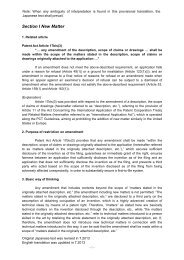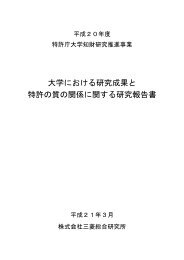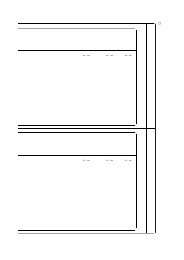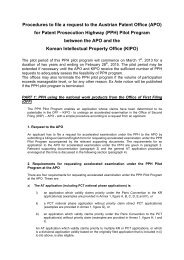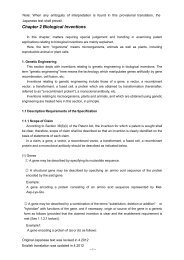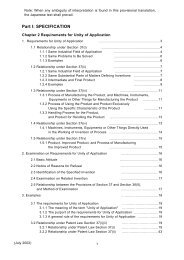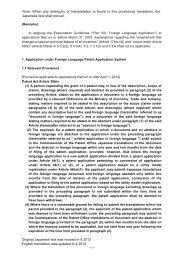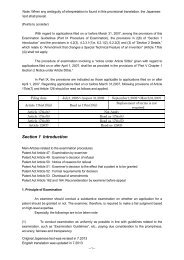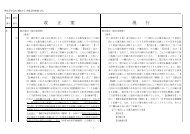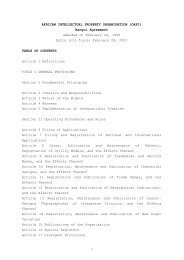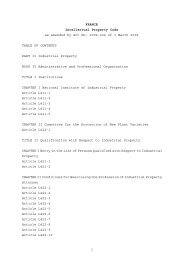Chapter 2 Novelty and Inventive Step - Japan Patent Office
Chapter 2 Novelty and Inventive Step - Japan Patent Office
Chapter 2 Novelty and Inventive Step - Japan Patent Office
You also want an ePaper? Increase the reach of your titles
YUMPU automatically turns print PDFs into web optimized ePapers that Google loves.
Part II <strong>Chapter</strong> 2 <strong>Novelty</strong> <strong>and</strong> <strong>Inventive</strong> <strong>Step</strong><br />
common general knowledge, <strong>and</strong> facts derived from the facts based on the common general<br />
knowledge taken in a situation where the inventions have been worked could be a basis for<br />
identifying the inventions that were publicly worked.<br />
(3) Inventions described in publications<br />
I. "Inventions described in publications" are identified based on "the descriptions in the<br />
publications." The descriptions are able to be interpreted based on the common general<br />
knowledge, <strong>and</strong> any facts that a person skilled in the art could derive from the description in the<br />
publications based on the common general knowledge as of the filing date, or equivalents to such<br />
descriptions in the publications, could also be a basis for identifying the inventions described in<br />
publications. In other words, "inventions described in publications" means inventions that a<br />
person skilled in the art is able to underst<strong>and</strong> based on the descriptions in publications or<br />
equivalents to such descriptions.<br />
Accordingly, inventions that a person skilled in the art is not able to underst<strong>and</strong> based on<br />
the descriptions in the publications or equivalents to such descriptions are not included in either<br />
"inventions described in publications" or "cited inventions." For example, when one "description in<br />
a publication" is part of the alternatives in the claims described in the Markush form, it is<br />
necessary to check if person skilled in the art is able to underst<strong>and</strong> an invention that provides<br />
either one of the alternatives as a requisite to define the invention.<br />
Example of "equivalents to the descriptions"<br />
[Example 1] A method that the conductor is grounded as a shielding means for preventing<br />
electrical interference is recognized as common general knowledge in the electricity-related field,<br />
<strong>and</strong> it is presumed that a person skilled in the art may underst<strong>and</strong> as a matter of course that the<br />
shield plate for the switch disclosed in the examples is intended to be connected to the earth,<br />
regardless of the absence of the such examples in the document. In view of Utility Model Act<br />
Article 3, it is reasonable to say that "devices described in publications" in Article 3(1)(iii) are<br />
considered to be a technical idea that person skilled in the art is able to clearly underst<strong>and</strong>….The<br />
fact that the shielding plate in the example is expected to be connected to the earth should be<br />
included in the technical meanings of the term "shielding plate" per se exemplified in the<br />
document <strong>and</strong> also be substantially equivalent to an actual description in the document.<br />
(Reference: Decision by the Tokyo High Court, November 29, 1982<br />
[Showa 56 (Gyo Ke) 93])<br />
Example of "not equivalents to the descriptions"<br />
[Example 2] The working example 6 in the cited document shows attapulgite clay (acidic<br />
components), which has the same effect as citric acids <strong>and</strong> is insoluble in a solvent. In short, it is<br />
reasonably understood that this example merely shows using insoluble phenol resins since<br />
insoluble substances are usually applied as a conventional acid component in this field.<br />
Accordingly, the example is not considered to provide a description for a substance soluble in the<br />
solvent with the same component as basic components selected from "phenol resins."<br />
(Reference: Decision by the Tokyo High Court, October 5, 1982<br />
[Showa 55 (Gyo Ke) 12])<br />
II. When an invention of a product or process is not clearly described enough that person<br />
skilled in the art is able to manufacture the product or use the process based on the descriptions<br />
of the publications <strong>and</strong> the common general knowledge as of the filing, the invention is not<br />
included in "cited inventions."<br />
For example, when a chemical substance is described merely by its name or its chemical<br />
11



